Excerpts from Jim Conrad's
Naturalist Newsletter
entry from field notes dated April 14, 2022, taken in disturbed/reforesting borderline cloudforest within 1km of Valle de los Fantasmas, elevation ±2,320m (7600 ft), with limestone bedrock; about 40kms (24 miles), straight-line, ESE of San Luis Potosí, San Luis Potosí state, MÉXICO, (N22.06°, W100.62°)
"ENCINO" OAK

Looking for a spot to camp overnight, I climbed toward a densely forested splotch on the much-disrupted landscape. It turned out to be Mexican Cedar trees, Cupressus lusitanica, closely planted in ranks and files, maybe 25 years ago, on a steep slope. It looked like the whole mountain had been completely deforested, then the cedars were planted to bring the inevitable erosion under control. The slope was too steep for a tent, except in one spot where a big oak had gathered a relatively level, tent-size spot right at its base. The tree cutters evidently had left this tree standing, for it was the only big one around. At this season the oak was mostly leafless, but issuing new leaves and flowers, as shown above. Below, you can see my tent on a dense carpet of the big tree's leaves, nudged up against the tree's thick trunk:
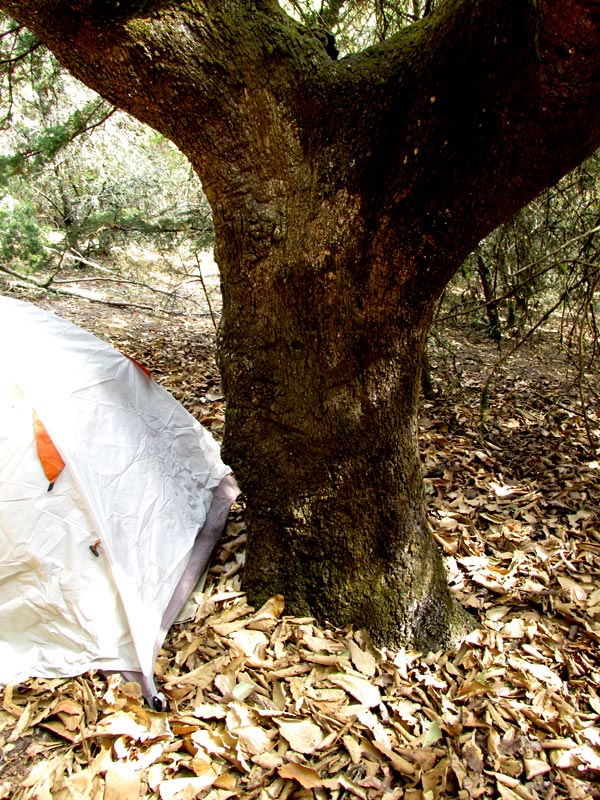
In a 2015 issue of Botanical Sciences, José Luciano Sabás-Rosales and others published the paper "Diversidad, distribución y caracterización básica del hábitat de los encinos (Quercus: Fagaceae) del Estado de San Luis Potosí, México" in which 45 oak taxa were documented for the state of San Luis Potosí. So, which of the 45 was this?
The emerging leaves and dangling aments of male flowers seen at the top of this page display important field marks. The leaves have scalloped margins, and are wider beyond their middles than at their bases. The young stems and the bottoms of the young leaves are fuzzy-hairy. Flowers in the slender aments are widely spaced on the dangling rachises, not crammed together. As shown below, last season's leaves on the ground showed that they could get rather large and varied in shape, and that they were leathery in texture:
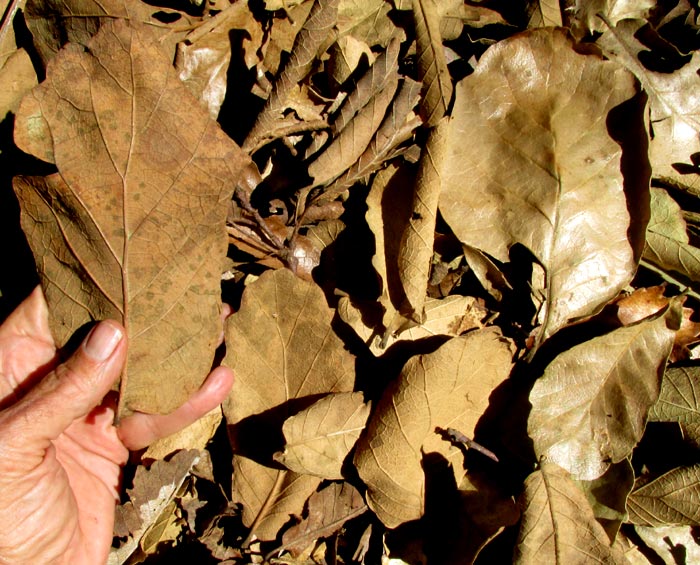
The leaves' bases often are asymmetrical, and secondary veins number up to about 8 on each side of the midrib. Upper surfaces of older leaves are hairless and shiny, but duller below. Below, the close-up shows the remains of hairs after a season or maybe more of hanging on the tree, so a good guess is that newly formed but mature leaves have fairly hairy undersurfaces.
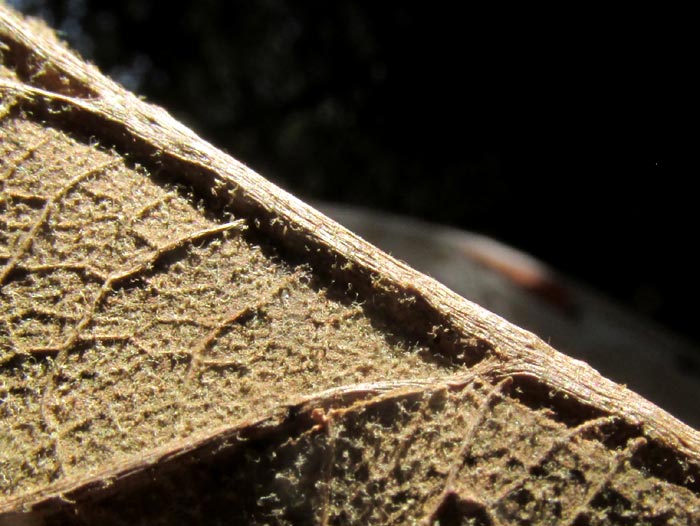
Now I looked for last season's acorns, and in a cavity at the base of the tree's trunk looking like a good place for a rodent to gnaw on some acorns, the acorn remains shown below were found:
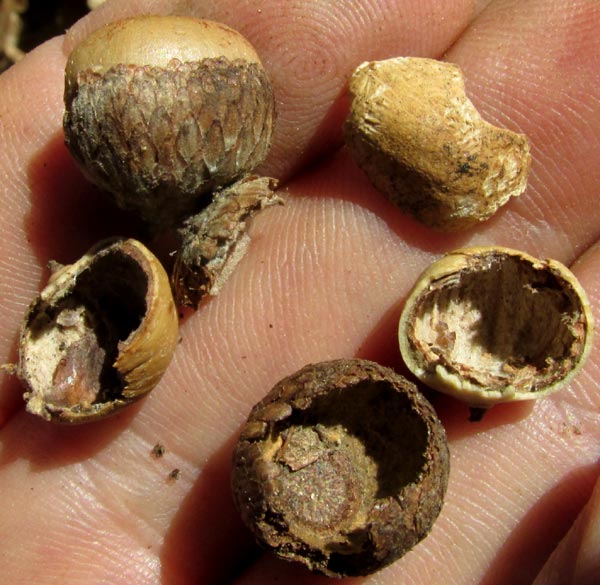
Important fieldmarks include the fact that the acorns have very short or no stems, as indicated by the cups in the picture's upper, left corner. The cups cover most of the nut, and at the bottom of the picture it appears that the cup can actually cover over some of the nut's upper part.
Despite all these distinctive features, it wasn't easy to settle on the species name. There's a whole cluster of similar-looking species with overlapping features. I strongly suspected we had the commonly occurring, often abundant at this elevation Quercus obtusata, but I couldn't be sure just from reading technical species descriptions.
In the end, our pictures had to be compared to expertly identified herbarium specimen, many of which are posted online. For example, our aments of male flowers are particularly slender with sparse flower clusters. At the wonderful swbiodiversity.org website a pressed Quercus obtusata specimen was found with aments looking just like ours. These pictures can be clicked on to examine more closely.
At the same website, a pressed herbarium sheet of Quercus obtusata showed acorns just like ours, with short or no stems, and cups growing over much of the nuts' upper parts. The cups' scales look like ours, too.
So, QUERCUS OBTUSATA, which has no English name because the species doesn't occur naturally in English-speaking areas. Spanish names are all over the place, none of them in the least standardized. Typically they're just called encinos, which means "oaks." The species is endemic just to arid, upland central Mexico from about our location in San Luis Potosí state, south to Queretaro, Hidalgo and Michoacán. Despite its small distribution, it's often abundant between 1000-2800m (3300-9200ft). Its uses are similar to other large oaks -- firewood and charcoal, fenceposts, its tannin used to cure hides and pucker skin wounds -- though really the main "use" is to keep hillsides from eroding, put oxygen into the air, and support a lot of animals with their crops of acorns.
Another "use," at least for any sentient being with an aesthetic sense, is suggested by what's seen below, the view from my tent the next morning, up through the big tree's branches.
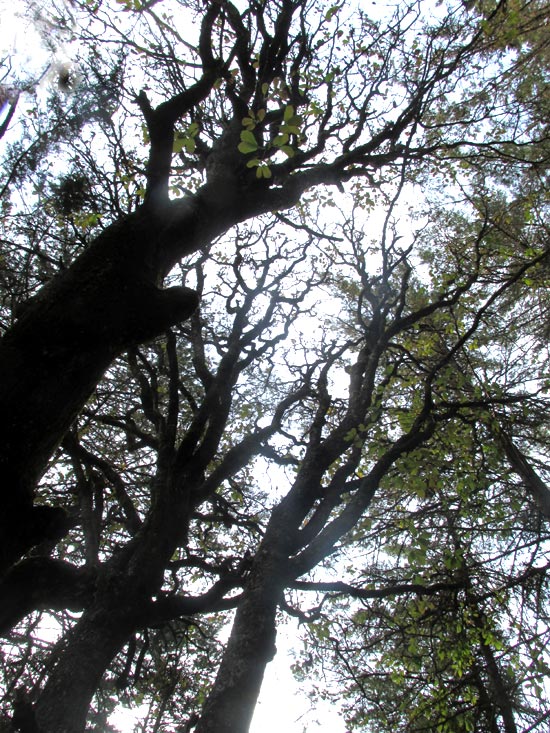
By the way, Quercus obtusata is a good old Humboldt and Bonpland name, published in 1809, after their epoch-making exploration of the Americas from 1799 into 1804. What an awful lot of fun those guys must have had.
Entry dated November 9, 2023, from notes taken near Cascadas de La Piedad waterfall 3kms NW of the community of San Pablo, municipality of Almeaco de Bonfil; oak forest atop bedrock of thick layers of compacted volcanic ash, or tuff; N20.1024°, W100.0019°, elevation 2360 meters (7750ft); extreme southern Querétaro state, MÉXICO
QUERCUS OBTUSATA WITH ACORNS
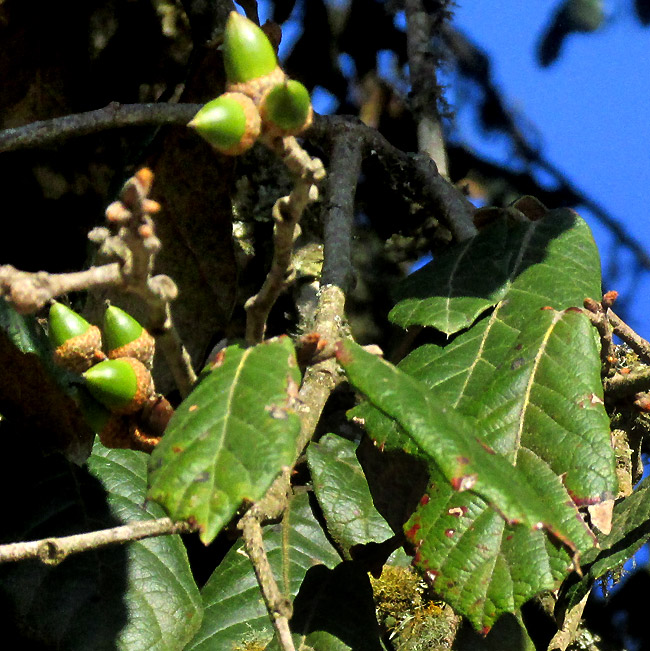
Entry dated November 9, 2023, from notes taken near Cascadas de La Piedad waterfall 3kms NW of the community of San Pablo, municipality of Almeaco de Bonfil; oak forest atop bedrock of thick layers of compacted volcanic ash, or tuff; N20.1024°, W100.0019°, elevation 2360 meters (7750ft); extreme southern Querétaro state, MÉXICO
OAK STEM GALL ON QUERCUS OBTUSATA
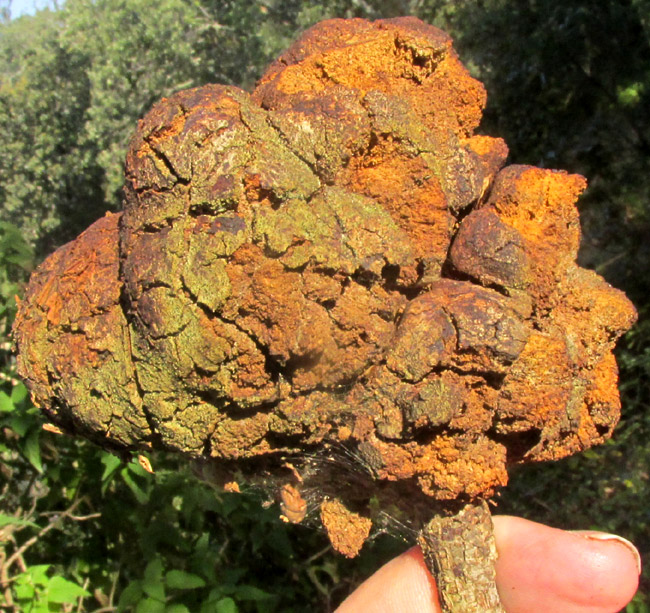
Atop a ridge covered with a somewhat open oak forest, the above gall attached to an oak stem had fallen onto the ground. It's an old one, deteriorating. Here's what it looked like broken apart:

On an Ohio State University webpage profiling a similar but different gall occurring on oak stems in Ohio, in the US, a picture of a broken-open gall shows a stem passing through the gall's center, which was the case with our gall. In the Ohio gall's center, an enlarged area of oak stem "disorganized vascular tissue" was visible; possibly in the above picture, the dark, more compact-looking zone in our gall is such disorganized stem tissue.

Several such galls had fallen beneath the bigoak. The gall pictured above lay beside leaves from that oak, identifying the tree as Quercus obtusata.
The above-mentioned Ohio State page identified the cause of such galls as a gall-wasp species of the Gall Wasp Family, the Cynipidae. Wasps induce the galls by laying eggs on the stems. When the eggs hatch, they eat the gall tissue which has grown to surround them.
On the GBIF Occurrences page for the Cyipidae, which occur nearly worldwide, numerous gall wasp species were documented for our part of highland central Mexico. After comparing our galls with many images of galls observed in our area, caused by members of the Cynipidae, it became clear that the vast majority of Cynipidae galls are smooth and occur on leaves, not stems. However, species of the genus Andricus produced galls some of which became hard and semi-woody like ours.
On the GBIF Occurrences page for the genus Andricus, several species were documented for our highland central Mexican region. Of those species, Andricus quercuslaurinus was mentioned, and on oak trees it produced galls looking like ours. The process is much more complicated by that, nicely described on Wikipedia's Gall Wasp page.
The 2019 study by Karina Ortega-Rivera and others entitled "Caracterización del estado fitosanitario de Quercus obtusata Bonpl., en bosque mesófilo de montaña, Xicotepec, Puebla," singles out our Quercus obtusata as exhibiting a high degree of vulnerability and threat -- "... alto grado de vulnerabilidad y amenaza" -- to the genus Andricus in their study area in Puebla state. Also, they mention "fateful effects of galls in oak forests" .."fatídicos efectos de las agallas en encinares," produced by our suspected Andricus quercuslaurinus. Sometimes trees host large numbers of such galls.
The problem caused byAndricus quercuslaurinus galls is that stem tissue is weakened and killed, so that stem tips later die and break away, as had happened beneath our oak.